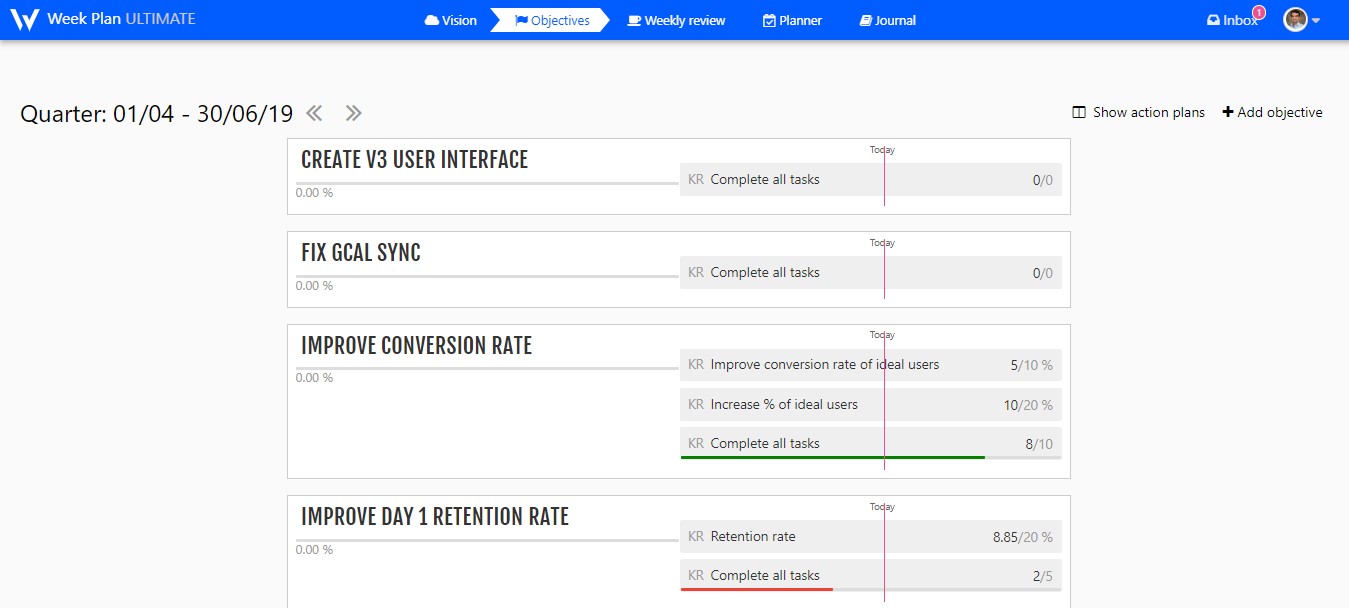
OKRs are now one of the preferred goal-setting methodologies for any company because it is a proven way to accomplish more results in less time.
According to a survey, 40% of CEOs consider linking the workforce with the strategic initiatives of the business as their first priority.
But the problem is that creating OKRs is not a walk in the park as it requires following certain practices to make the most out of them.
There is a wide range of OKRs best practices that can boost the chances of achieving goals.
As mentioned earlier, setting up OKRs is not as easy as it seems. But, you don’t need to stress out, as this piece will detail you about best OKR practices for adopting the process.
The key ingredients to make a perfect OKRs are as follows;
1 - OKRs should be Ambitious

Ambitious OKRs are far better as compared to other OKRs. They allow you to deliver your best because you know that there is a long way to go. If your targets are tough then you definitely put extra efforts to meet them. So, you must think big while creating OKRs.
With Ambitious OKRs you will try to develop a sense of determination and desire to succeed in your workforce.
2 - OKRs Should Be Public

The OKRs you set should be accessible to every member of the team. There is no point in keeping them a secret, as everyone is working towards achieving a mutual goal. A transparent atmosphere, not only motivates your workforce, but it also creates a healthy competition among one another.
3 - OKRs Should Be Quantifiable

One of the best practices to keep in mind while creating OKRs is to be quantifiable. You need to make sure that OKR objectives your set are goal-oriented, and you have to have proper performance indicators to measure the key results.
Quantifiable OKRs are quite effective to track if the objectives of an OKRs are met or not. If your OKRs have a numerical point of reference linked with them then it would be extremely easy to monitor the progress.
4 - OKRs Grading

Setting OKRs on the basis of the grading system is essential to monitor the progress. It helps in determining what’s done and what’ left. Google also makes use of the grading system. They grade their OKRs from 0 to 1, so that they can easily check the performance of their OKRs. According to them, OKRs that grades between 0.6 to 0.7 are ideal.
5 - Ensure that Your Objectives Are Between 3 to 6 at a Time

While starting with OKRs methodology, many people struggle with the number of objectives. The best practice for that is to keep your OKRs between 3 to 6.
Rick Klau, the Google venture partner, also said that the employees of Google set 3 to 6 objectives each quarter.
So, instead of creating too many OKRs, it’s better to keep your OKRs realistic as discussed above to avoid the troubles of unaccomplished results.
6 - Set OKRs Quarterly For Teams and Individuals

Normally, teams and individuals support OKRs that are based annually but that’s not the right way to deal with OKRs.
The correct way to make use of OKRS is by setting them quarterly. This provides you with the feasibility to change and adapt them instantly. This agility gives the opportunity to adjust OKRs 4 times a year without waiting too much.
7 - Set Annual OKRs for Company

It is essential that you don’t confuse the objectives of the company with that of the individual objectives of the employee. There is no comparison between the two. Individual objectives collectively contribute to the main goal of the organization.
Company objectives should be set annually because business publishes their performance reports annually. So, it’s better to set the objectives for the organization at the top-level business, and they should be set for an entire year instead of aiming for a quarterly basis.
8 - Include 3 Key Results under Each Objective

Deciding on key results associated with an objective is not a piece of cake. It is crucial that you set justifiable key results to make it achievable. You don’t want to add too many key results with an objective to make it look impossible to achieve, and similarly, you wouldn’t want to include fewer key results to make your objective look like non-ambitious. So, the best practice is to keep your key results under 3 if you want to make a perfect OKR.
9 - OKRs should be Time-bound

Your job doesn’t end at setting OKRs, it is your responsibility to make them time-bound. Making OKRs time-bound means setting a deadline for their completion. Setting deadlines not only help to motivate your employees to finish their jobs on time but also enables you to track if they have attained key results on time or not.
10 - Setting OKRs that are Achievable

OKRs should be challenging but achievable. When you set your OKRs, you must ensure that they are challenging yet achievable.
The CEO of LinkedIn, Jeff Weiner, encourages his team to set goals that test them to cores and are not so easy to accomplish. It helps his team to stay focused on their goals so that they derive better results.
11 - Set OKRs that Are Inspiring

Many organizations focus on creating OKRs that are challenging but they forget to concentrate on the inspirational part of the OKRs. The best OKRs are not only challenging, but they are also inspiring as well. So, make sure that your OKRs look inspiring so that your employees are willing to go the extra mile needed to accomplish them.
12 - Have a Clear Mission in Mind

Before setting objectives, you must have a clear mission like why you are setting that OKRs and what is the objective that you want to achieve from that OKRs. It not only enables you to create the right OKRs but also provides you with the elevation needed to achieve it because you have a purpose in mind with that OKRs.
13 - OKRs Should Have Defined Owners

In order to make an effective OKRs, it is extremely important that the OKRs is drafted and owned by a single responsible person like for individual OKRs - an employee can be the best owner, for team-level OKRs - a team leader is a right person to set OKRs and for company-level OKRs, it should be either CEO or someone from the upper management team.
14 - Involve Team Members While Creating OKRs

Taking suggestions from team members is always a good practice before creating OKRs for them because it enables them to share their ideas to make OKRs more engaging. It helps them to stay motivated while working on the agreed-upon OKRs because they were directly involved in the process of creating them.
15 - Be Consistent with OKRs

Consistency is the key to master the OKR system. You need to be vigilant and consistent when it comes to the creation and tracking of OKRs. You should have created your OKRs when you see that existing ones are near completion.
Establishing OKRs beforehand gives you the luxury to make adjustments according to the results and performance of the team, to make them more precise and effective.
16 - Make Use of Tool for Tracking Progress

Tracking OKRs manually is a time taking process because there are many parameters that you have to keep in mind in order to be tracked accurately. The best practice is to make use of OKR tools. These tools are specifically designed to monitor each and every key result attached to your OKRs to ensure that you are going smoothly towards accomplishing them.
Wrapping Up
If you have implemented OKRs in your organization for a while, then you must know better what works for you and whatnot. But, if you have just stepped into this framework then it is better to follow the best practices before creating OKRs.
The OKRs best practices described in this article will not only allow you to keep your team aligned with the mission and vision of the organization but also helps them to achieve the essential milestones of the business timely.

More Posts
10 Tips for Conducting an Effective Brand Audit
Conducting a brand assessment is an essential process to remain competitive in today’s dynamic marketplace. A comprehensive strategic brand assessment not only helps identify the strengths and weaknesses of a brand but also...
How To Set Goals and Achieve Them
Where do you stand today? Where do you see yourself in five years? In ten? In twenty? If you find yourself lost for answers under the onslaught of this interrogation, you’re not alone....
12 Ways Successful Managers Spend Most of Their Time
Good leaders know how to manage their time well. They split their day smartly between personal and work tasks. Benjamin Franklin once said, "If you fail to plan, you are planning to fail."...
13 Time Management Tips for Middle School Students
Managing time is key for middle school students. They have school, hobbies, homework, and chores. Learning time management helps them do well in today's world. They learn to choose what's most important, stay organized, and...